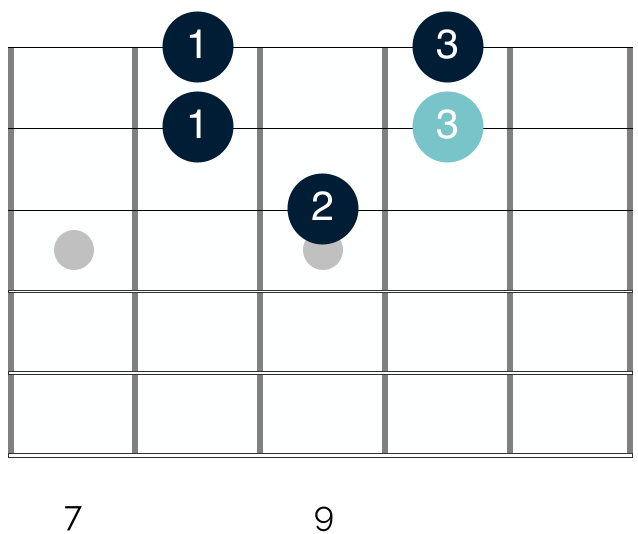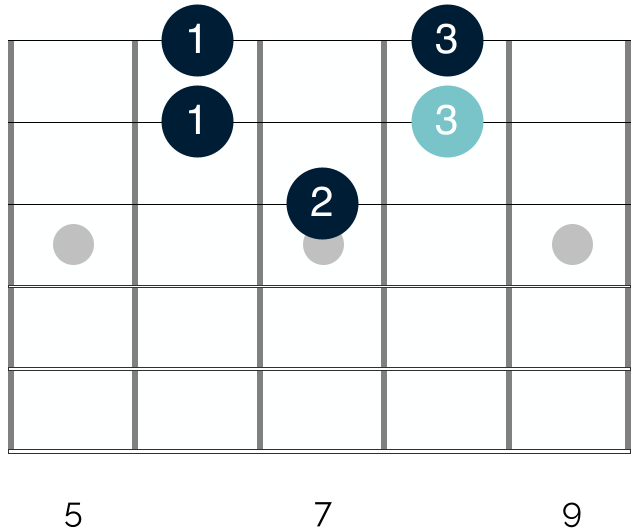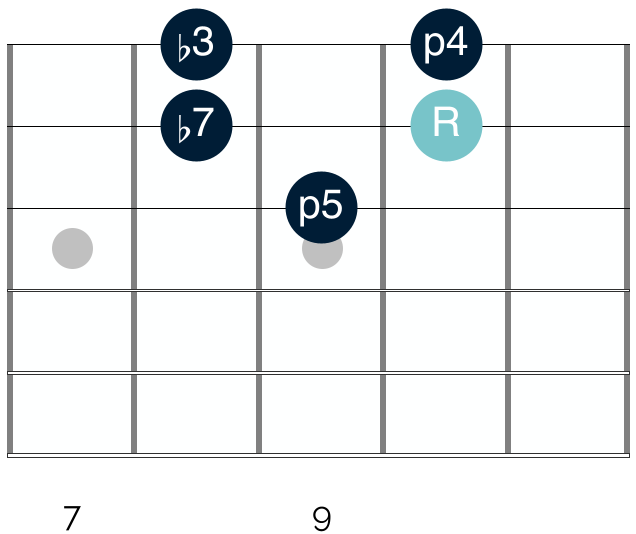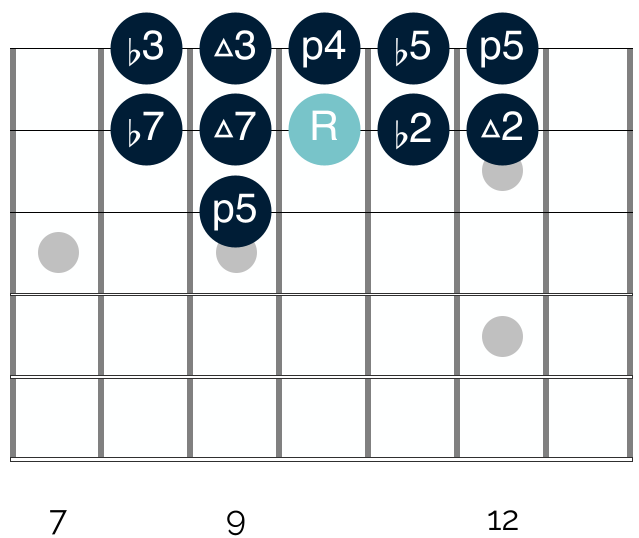If you want to channel the soloing style of Albert King and Stevie Ray Vaughan, I would recommend learning the Albert King Box.
As the name suggests, this is a box shape which Albert King used extensively in his playing. Just some of the many songs in which you can hear him solo using the box are as follows:
If you are a big fan of Albert King and Stevie Ray Vaughan (who was heavily influenced by King and used the box shape a lot in his playing) then the Albert King Box will help you to recreate some of their signature licks and capture the feel of their playing.
Even if these players don’t particularly resonate with you however, there are still a number of benefits of utilising the box in your playing.
I will be covering these in more detail throughout this lesson. First though, let’s look at exactly what the Albert King Box is, and where you can find it on the fretboard:
The Albert King Box
Many of the ‘box shapes’ that you encounter in the blues are simply groups of notes taken from a broader scale shape. It is no different with the Albert King Box.
As noted at the very beginning of the video above, the Albert King Box is simply a collection of 5 notes that appear in the second shape of the minor pentatonic scale.
This is what it looks like in the key of A:

I have highlighted the tonic note of A in blue, and shown the suggested fingerings I recommend when playing in the shape.
I suggest using these because they allow you to target the notes of the box with your strongest fingers. This is important as this allows you to bend and solo in the box more freely.
I will cover this in more detail below, but first we can look at where these notes appear within the second shape of the minor pentatonic scale:

This diagram simply shows the second shape of the minor pentatonic scale in the key of A. This time I have not highlighted the tonic notes of A highlighted. Instead I have highlighted the notes of the Albert King Box in yellow.
It is important to note that this box shape is moveable. These 5 notes always appear in the second shape of the minor pentatonic scale. As such, you can move this shape around the fretboard to play the box in the key of B, C and D etc.
In the key of G for example, you will find the Albert King Box 2 frets lower than in the key of A, as follows:

In this way, once you get comfortable with the box shape and how to craft licks and phrases using it, you can replicate these in a variety of different keys and musical contexts.
Before we look at how to do this in more detail below, it is worth addressing a question that you might be considering:
If the Albert King Box is just a collection of 5 notes from the minor pentatonic scale, why is it of such importance?
Beyond allowing you to recreate the specific licks of ‘The King of the Blues Guitar’, in my opinion there are three main benefits of targeting the box in your playing. The Albert King Box is:
1.) Compact
Firstly, the Albert King Box is very compact. This is true of all of the ‘box shapes’ that blues guitarists target – including the ‘B.B. King Box‘.
The contained and compact nature of these boxes is beneficial for a variety of reasons:
If you are relatively new to playing blues lead guitar, then focusing on a compact box like this one can limit the mental load of improvisation. You don’t have to worry about navigating all over the fretboard and instead can focus on your phrasing and technique.
So if you find that you get easily overwhelmed when trying to create licks – limiting your focus to a small box shape like this can do a lot to make you feel more comfortable.
Even if you are more an advanced player however, limiting your focus in this way can be beneficial. When you develop as a guitarist it can be very tempting to think that the answer to further development lies in more complex scales.
Yet the Three Kings of the Blues – in addition to a variety of further blues guitarists – all illustrate the importance of phrasing and technique.
In other words in the blues, how you breathe life into the notes that you play and join them together into licks is more important than being able to fly all over the fretboard.
A perfect example of this is Albert King’s opening solo in ‘Blues Power‘.
The solo is largely based around simple note groupings in the Albert King Box. Yet the power and intensity of King’s bending, technique and phrasing transform these notes into a very impactful solo.
As such, regardless of your playing level, playing in the Albert King Box can help to keep you focused on your phrasing and articulation – both of which are essential if you want to craft emotive blues guitar solos.
2.) Intervalically interesting
The Albert King Box simply contains the 5 notes of the minor pentatonic scale. The way in which these notes are arranged however is notable and allows you to effectively manipulate tension and resolution in your playing.
To understand why this is the case, it is worth briefly discussing intervals.
To cover this topic in depth is beyond the scope of this lesson. If you would like to learn more though, just head over to the full course – An Introduction To Intervals.
For now though don’t worry – we won’t dive super deep into the theory.
Instead we will just cover some of the essentials to help you understand why the Albert King Box is so effective, and how you can target the notes of the box to craft a range of interesting blues licks.
If you are totally new to intervals, then they simply refer to the distance between notes. They also tell you the quality of any given note within a key.
For example, some intervals have a resolved and consonant sound, whilst others have a much more tense and dissonant sound.
The intervals in the minor pentatonic scales are as follows:
1 b3 4 5 b7
The 1, 4 and 5 intervals are all ‘perfect’ in quality. This means that playing them creates a ‘perfectly’ consonant sound and a strong sense of musical resolution.
Conversely, the b3 and b7 are minor in quality. These give the minor pentatonic scale its minor tonality, and its more melancholic and edgy sound.
These intervals do not create a resolved and consonant sound. Rather, they allow you to create a tense and bluesy feel in your playing.
Both the b3 and b7 sit between perfect intervals in the minor pentatonic scale. The b3 is a tone and a half above the tonic and a tone below the perfect 4th.
Likewise, the b7 is a tone and a half above the perfect fifth and a tone (whole step) below the perfect tonic.
In this way, these intervals are brilliant to target with bends, slides, and hammer ons and pull offs. You can use them to create tension before resolving to one of the nearby intervals with a perfect quality.
Part of what makes the Albert King Box effective is the way that these intervals are ordered. This is as follows:

The ‘starting note’ of the box is the perfect fifth at the 7th fret on the G string, and the tonic note is at the 8th fret on the B string.
The remaining 3 notes all lend themselves perfectly to string bending, as well as techniques likes slides, hammer ons and pull offs. In this way you can create and resolve tension quickly and fluidly in a very compact section of the fretboard.
Not only this, but the box shape lends itself well to targeting the 5th at the end of your phrases.
This is significant. Blues guitarists will often target the tonic at the end of their phrases because of the very strong resolution it creates.
As I discussed in much more detail in this quick win lesson here though, targeting the 5th offers a great alternative and allows you to create more variety in your playing.
To test some of these ideas out, simply play the Albert King Box over one of the following back tracks:
- Playing The Changes – A Practical Approach
- Minor Blues – Soloing Over the V Chord
- The Thrill Is Gone Turnaround
- Minor Blues – The i to iv Change
- Weeks 7 & 8 – Blues Power Practice Plan (30 Minutes)
- Weeks 7 & 8 – King of the Blues Practice Plan (60 Minutes)
- Weeks 7 & 8 – Blues Deluxe Practice Plan (45 Minutes)
- The Turnaround – Major Blues
- IV-I Chord Soloing Options (Major Blues)
- IV Chord Soloing Options (Major Blues) – 5 Note Solo
- IV Chord Soloing Options – Major Blues (Not the F#)
- IV Chord Soloing Options – Major Blues (Targeting the F#)
- IV Chord Soloing Options – Major Blues (Step I)
- I Chord Soloing Options – Major Blues
- Bringing the B.B. Vibe in Box V Example Solo
- Weeks 5 & 6 King of the Blues Practice Plan (60 Minutes)
- Weeks 5 & 6 Blues Power Practice Plan (30 Minutes)
- Weeks 5 & 6 Blues Deluxe Practice Plan (45 Minutes)
- Crossroads Backing Track
- Don’t Answer The Door Backing Track
- A Major Pentatonic Scale Shapes
- Bringing More Blues Power In Box IV Example Solo
- A Major Pentatonic Box Shape I Solo
- A Major Pentatonic Scale Shapes
- G Minor Pentatonic Scale Shapes
- Weeks 3 & 4 King of the Blues Practice Plan (60 minutes)
- Weeks 3 & 4 Blues Deluxe Practice Plan (40 minutes)
- Weeks 3 & 4 Blues Power Practice Plan (30 minutes)
- I Shot the Sheriff Backing Track
- Combining Rhythmic & Melodic Motifs in B Minor
- Rhythmic Motif in B Minor
- Blues Pop Ballad in B Minor Backing Track
- Melodic Motif Solo in B Minor
- Hey Joe Solo
- Week 2 – King of the Blues Practice Plan (60 minutes)
- Week 2 – Blues Deluxe Practice Plan (45 minutes)
- Week 2 – Blues Power Practice Plan (30 minutes)
- The power of the tonic note – short solo
- Week 1 – King Of The Blues Practice Plan (60 mins)
- Week 1 – Blues Deluxe Practice Plan (45 mins)
- Week 1 – Blues Power Practice Plan (30 mins)
- B Minor Pentatonic Scale Diagrams
- The Thrill Is Gone Backing Track
- Stop Targeting The Tonic Intro Solo (Audio)
- Stop Targeting The Tonic Intro Solo (Tab)
- Superstitious Blues In A Minor Backing Track
- Black Magic Woman Backing Track
- 5 Bending Mistakes Intro Solo (Audio)
- D Aeolian Mode Scale Shapes
- D Minor Pentatonic Scale Shapes
- 5 Bending Mistakes Intro Solo (Tab)
- Slow Blues in D Minor Backing Track
- Tightrope Backing Track
- Chilled Blues In A Minor Backing Track Tab
- Chilled Blues In A Minor Backing Track
- C Aeolian Mode Scale Shapes
- Groovy Aeolian Blues In C Minor Backing Track Tab
- Groovy Aeolian Blues In C Minor Backing Track
- Funky Jazz Blues In E Backing Track Tab
- E Minor Pentatonic Scale Shapes
- Funky Jazz Blues In E Backing Track
- Smooth Blues In A Minor Backing Track Tab
- A Minor Pentatonic Scale Shapes
- Smooth Blues In A Minor Backing Track
- Wonderful Tonight Backing Track
- G Major Pentatonic Scale Shapes
- G Major Scale Shapes
- Tightrope Scales
- Comfortably Numb Backing Track
- Hey Joe backing track
- Strange Brew backing track
- A Minor Blues Scale Shapes
- A Minor Pentatonic Scale Shapes
- Need Your Love So Bad
- A Major Pentatonic Scale Shapes
- Blues Pop Ballad In B Minor
- B.B. King Style Track In G
- Upbeat Blues Shuffle In E
- Slow Blues In A Minor Backing Track
- Funky Blues In A Major
- Playing The Changes – A Practical Approach
- Minor Blues – Soloing Over the V Chord
- The Thrill Is Gone Turnaround
- Minor Blues – The i to iv Change
- Weeks 7 & 8 – Blues Power Practice Plan (30 Minutes)
- Weeks 7 & 8 – King of the Blues Practice Plan (60 Minutes)
- Weeks 7 & 8 – Blues Deluxe Practice Plan (45 Minutes)
- The Turnaround – Major Blues
- IV-I Chord Soloing Options (Major Blues)
- IV Chord Soloing Options (Major Blues) – 5 Note Solo
- IV Chord Soloing Options – Major Blues (Not the F#)
- IV Chord Soloing Options – Major Blues (Targeting the F#)
- IV Chord Soloing Options – Major Blues (Step I)
- I Chord Soloing Options – Major Blues
- Bringing the B.B. Vibe in Box V Example Solo
- Weeks 5 & 6 King of the Blues Practice Plan (60 Minutes)
- Weeks 5 & 6 Blues Power Practice Plan (30 Minutes)
- Weeks 5 & 6 Blues Deluxe Practice Plan (45 Minutes)
- Crossroads Backing Track
- Don’t Answer The Door Backing Track
- A Major Pentatonic Scale Shapes
- Bringing More Blues Power In Box IV Example Solo
- A Major Pentatonic Box Shape I Solo
- A Major Pentatonic Scale Shapes
- G Minor Pentatonic Scale Shapes
- Weeks 3 & 4 King of the Blues Practice Plan (60 minutes)
- Weeks 3 & 4 Blues Deluxe Practice Plan (40 minutes)
- Weeks 3 & 4 Blues Power Practice Plan (30 minutes)
- I Shot the Sheriff Backing Track
- Combining Rhythmic & Melodic Motifs in B Minor
- Rhythmic Motif in B Minor
- Blues Pop Ballad in B Minor Backing Track
- Melodic Motif Solo in B Minor
- Hey Joe Solo
- Week 2 – King of the Blues Practice Plan (60 minutes)
- Week 2 – Blues Deluxe Practice Plan (45 minutes)
- Week 2 – Blues Power Practice Plan (30 minutes)
- The power of the tonic note – short solo
- Week 1 – King Of The Blues Practice Plan (60 mins)
- Week 1 – Blues Deluxe Practice Plan (45 mins)
- Week 1 – Blues Power Practice Plan (30 mins)
- B Minor Pentatonic Scale Diagrams
- The Thrill Is Gone Backing Track
- Stop Targeting The Tonic Intro Solo (Audio)
- Stop Targeting The Tonic Intro Solo (Tab)
- Superstitious Blues In A Minor Backing Track
- Black Magic Woman Backing Track
- 5 Bending Mistakes Intro Solo (Audio)
- D Aeolian Mode Scale Shapes
- D Minor Pentatonic Scale Shapes
- 5 Bending Mistakes Intro Solo (Tab)
- Slow Blues in D Minor Backing Track
- Tightrope Backing Track
- Chilled Blues In A Minor Backing Track Tab
- Chilled Blues In A Minor Backing Track
- C Aeolian Mode Scale Shapes
- Groovy Aeolian Blues In C Minor Backing Track Tab
- Groovy Aeolian Blues In C Minor Backing Track
- Funky Jazz Blues In E Backing Track Tab
- E Minor Pentatonic Scale Shapes
- Funky Jazz Blues In E Backing Track
- Smooth Blues In A Minor Backing Track Tab
- A Minor Pentatonic Scale Shapes
- Smooth Blues In A Minor Backing Track
- Wonderful Tonight Backing Track
- G Major Pentatonic Scale Shapes
- G Major Scale Shapes
- Tightrope Scales
- Comfortably Numb Backing Track
- Hey Joe backing track
- Strange Brew backing track
- A Minor Blues Scale Shapes
- A Minor Pentatonic Scale Shapes
- Need Your Love So Bad
- A Major Pentatonic Scale Shapes
- Blues Pop Ballad In B Minor
- B.B. King Style Track In G
- Upbeat Blues Shuffle In E
- Slow Blues In A Minor Backing Track
- Funky Blues In A Major
Refer to the diagram above which shows the intervals in the scale and try pausing on different intervals to see the feeling they create over the track.
Once you have a sense of which intervals create tension and which resolve it, you can start to experiment with creating a range of licks in the box shape.
3.) Perfect for bending
As you start to go through this process, make sure that you get inventive with your string bends. The Albert King Box and its structure lends itself very well to a variety of string bends.
In my opinion – at least when you are starting out – the 5th and tonic are best left as points of resolution. However you can target the other 3 notes with a variety of string bends.
If you want to stay within the framework of the minor pentatonic scale, then you have the following options:
- At the 8th fret on the B string, you can bend up a tone from the b7 to the tonic
- When playing on the E string, you can do the same at the 8th fret, moving from the b3 to the 4th
- At the 10th fret on the E string, bending a tone will push the 4th up to the next note in the minor pentatonic scale (the 5th)
When you combine these bends with other techniques like slides, hammer ons and pull offs, you can get a huge mileage out of this compact box shape.
I illustrate this from just before the 40 second mark in the video above, where I play the following lick:

At 100 beats per minute (BPM) this is how this lick sounds:
Part of this mileage comes from the fact that bending is such a nuanced technique. In the 3 bar lick illustrated above for example, I execute three different types of bends.
If you are new to bending, then I cover a wide range of further bending techniques in these two courses:
In short though, when you are bending, think about all of the ways you can vary the technique to get as much mileage from it as possible.
The only technical challenge when you are doing this, is that you need to execute those on the left hand side of the box with you first finger.
If you don’t, then you will find yourself jumping back and forth across the box, which will make it very difficult to phrase with any kind of fluidity or speed.
If you have not yet tried bending with your first finger, it will feel awkward and challenging at first. Stick with it though, as it will provide you with many more options when bending – not just in the Albert King Box but all over the fretboard.
If you have moved beyond the minor pentatonic scale in your playing and also feel comfortable with string bends of different pitches, then the Albert King Box offers even more opportunity for bending.
We can see this if we look at a diagram showing some of the notes that sit in and above the box shape in the key of A:

If you don’t yet feel comfortable with intervals or with the intervals from different scales, then this diagram is likely to be a little overwhelming.
If that is the case, then don’t worry. Just focus on the bending options listed above and work to craft a variety of interesting licks over the backing tracks. You can then come back to this material in the future.
If you do feel comfortable with these concepts, then this diagram helps to illustrate all of the potential you can get from this small box shape.
On the E string for example you can:
- Bend the 8th fret up a semitone to target the major 3rd from the major pentatonic scale
- Target the 10th fret with a semitone bend. This moves you from the perfect 4th to the b5 – the spicy and dissonant blue note from the blues scale
- Bend the 10th fret a tone to move from the perfect 4th to the resolved and consonant perfect 5th
The same potential exists on the B string. In this way, without moving outside of the Albert King Box you can target a wide range of different notes with bends.
These notes are contained within different scales and as such, also illustrate how you can use the box shape in different musical contexts.
Closing thoughts
Playing effective lead blues guitar is a multi-faceted and complex challenge.
You have to navigate across the fretboard, use a range of different techniques and phrase in a way that is authentically bluesy.
The Albert King Box is not a magic bullet that will immediately help you to craft a range of killer licks.
However it does help to focus your approach. You can strip away a lot of the mental load of wondering where to play and can instead work to bring the notes of the Albert King Box to life.
Not only will this help you to create a distinct Albert King and SRV vibe in your playing, it will also make you a better blues guitar player.
Specifically, it will develop your ability to craft a wide range of nuanced bends. It will also help you to develop your phrasing and build your ability to target different intervals in your playing.
Good luck dialling in those Albert King licks!
Let me know how you get on, and if you have any questions about how to use the box shape, just send them across on your dashboard. I am always around and happy to help 😁
